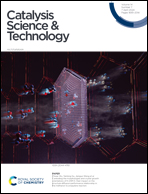Coordinating the interaction of ZnO and ZrO2 for an efficient ethanol-to-butadiene process†
Abstract
As a sustainable, environmentally friendly, and economically viable way to produce 1,3-butadiene, the ethanol-to-butadiene (ETB) process has received increasing attention recently. This ETB process normally requires catalysts with suitable acidity and basicity, namely an acid–base balance. However, the origin of acid–base balance has not yet been elucidated. Herein, we demonstrate that by finely coordinating the interaction of ZnO and ZrO2, a butadiene productivity of 0.33 gBD gcat−1 h−1 at low WHSV and 1.39 gBD gcat−1 h−1 at high WHSV can be achieved. In contrast, pure ZnO prefers ethanol dehydrogenation to acetaldehyde and pure ZrO2 favors ethanol dehydration to ethylene and diethyl ether. Through a variety of characterization techniques, we found that the interaction of ZnO and ZrO2 alters the acidity and basicity of catalysts, resulting in volcanic shapes of ethanol conversion, butadiene selectivity, and butadiene yield in the ETB process. These findings provide in-depth insights into the understanding of the ETB process and may also apply to other reaction systems using ZnO–ZrO2 as catalytically active components.



 Please wait while we load your content...
Please wait while we load your content...